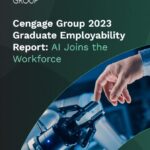Workplaces are increasingly dropping degree requisites for many roles that historically were only available to college graduates. Delta, Dell, IBM, and Bank of America have all removed the college degree requirement for some of their roles. And while many jobs still require the advance education that a college degree provides, there is a growing demand among employers for a stronger alignment between what students are taught in college and the job skills that they will need to use in their careers.
Where is the gap?
In the decision sciences, for example, most college graduates would have learned business analytics using traditional math and statistics methods but aren’t always taught how to use spreadsheets or programming languages like Python. Or, in accounting, the feedback from employers is that many graduates are arriving to jobs without specific skills – like data analytics, for example. Such skill gaps can hinder new hires from having an impact on day one of a job, causing frustration among both employers and recent graduates.
Shifting curriculum to be more job relevant means instructors and course materials providers need to stay on top of the latest advances in each field. We are addressing this by developing our products with languages like Python, or tools like Excel baked into the learning objectives. In fast-moving areas like computing, we are working with partners to make sure students are getting the instruction they need; for example, we are integrating GitHub Codespaces right into our MindTap learning platform, so computing students can truly learn to code in a real environment during their college courses. We are also implementing MindTap MOSS (Medical Office Simulation Software) exercises into Medical Office Administration courses, allowing students to complete activities much like they would in the workforce.
“Allowing students the opportunity to work in a simulated software system, completing activities much like they will in the workforce, helps them implement the skills they are learning in the chapter. Many students are hands-on learners and these activities provide them with that opportunity.” — Amanda Beaman, Department Chair of Phlebotomy and Medical Office Administration, Montgomery Community College
What can faculty do?
What does a stronger focus on transferable skills and employability look like for faculty members? How can they ensure their courses are structured to give students the outcomes they want and need to make the transition from learning to earning? Even the most experienced faculty members may find that they can’t “teach” job skills without tapping into the experience, opportunity and social capital offered by the working world. Thankfully, that’s all within reach. Here are three things faculty can do to bring that world a little closer to campus:
-
Adopt a partnership mindset
Many institutions are choosing to strengthen their offerings by partnering with relevant employers. When this happens, faculty can take the opportunity to turbocharge their pedagogy, resting assured that what they are teaching is backed by industry best practice, with an emphasis on the skills students will need for real jobs. Departmental advisory boards can strengthen bonds between institutions and workplaces, focusing on how curricula can be sharpened to give it an employability lens. Faculty may wish to join such boards. They may also choose to bring in guest lecturers who are experts in their respective fields to share insights with students.
-
Map learning to earning
In some disciplines, the best way to help students build job skills might just be to think like an employer. For example, a faculty member might use a powerful labor market data search engine or resource—like Indeed or Lightcast—to search for the keywords that hiring managers in a field are using when they advertise their job openings. From there, they can weave the development of the related competencies into their teaching. For example, a history adjunct – someone who might otherwise have very little connection to the working world – could run a search and find that 80% of job openings in museums require the use of a particular historical archive software, which they can weave into lessons as appropriate.
In the past few years, an array of open source and proprietary “skills libraries” have emerged to help people remove the guesswork from skills development and hiring. Although these are normally thought of as being solely for employers, they can be invaluable resources for educators. In short, the more faculty members can think like hiring managers – and use their tools to gain real-time labor market intelligence – the better off their students will fare.
-
Lean into digital opportunities
Virtual and remote internships, coops, apprenticeships and other work-based learning opportunities are some of the best ways to remove the geographical dependency from higher education. These experiences also let students build job skills and social capital early. Whether it’s a community college student completing an apprenticeship with a global bank from their home in rural Wyoming, or an agriculture student earning a sustainable farming microcredential from their studio in Brooklyn, digital opportunities can help students meaningfully plug into the world of work and add an extra layer of relevance to their learning. Faculty members can learn about and promote these digital opportunities to their students to ensure they get invaluable hands-on experience…well before they walk the stage.

For the 2023 Cengage Group Employability Report, we surveyed 1,000 recent graduates and 1,000 employers to understand their current feelings about employability, job skills, new technology and hiring and training plans. Download it now to explore the results.

